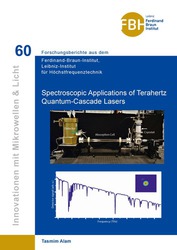| Fachbereiche | |
|---|---|
| Buchreihen (96) |
1378
|
| Nachhaltigkeit |
3
|
| Gesundheitswesen |
1
|
| Geisteswissenschaften |
2365
|
| Naturwissenschaften |
5406
|
| Mathematik | 229 |
| Informatik | 319 |
| Physik | 980 |
| Chemie | 1363 |
| Geowissenschaften | 131 |
| Humanmedizin | 243 |
| Zahn-, Mund- und Kieferheilkunde | 10 |
| Veterinärmedizin | 108 |
| Pharmazie | 147 |
| Biologie | 835 |
| Biochemie, Molekularbiologie, Gentechnologie | 121 |
| Biophysik | 25 |
| Ernährungs- und Haushaltswissenschaften | 45 |
| Land- und Agrarwissenschaften | 1004 |
| Forstwissenschaften | 201 |
| Gartenbauwissenschaft | 20 |
| Umweltforschung, Ökologie und Landespflege | 148 |
| Ingenieurwissenschaften |
1793
|
| Allgemein |
98
|
|
Leitlinien Unfallchirurgie
5. Auflage bestellen |
|
Erweiterte Suche
Spectroscopic Applications of Terahertz Quantum-Cascade Lasers
Tasmim Alam (Autor)Vorschau
Leseprobe, PDF (520 KB)
Inhaltsverzeichnis, PDF (27 KB)
Quantum cascade lasers (QCLs) are attractive for high-resolution spectroscopy because they can provide high power and a narrow linewidth. They are particularly promising in the terahertz (THz) range since they can be used as local oscillators for heterodyne detection as well as transmitters for direct detection. However, THz QCL-based technologies are still under development and are limited by the lack of frequency tunability as well as the frequency and output power stability for free-running operation.
In this dissertation, frequency tuning and linewidth of THz QCLs are studied in detail by using rotational spectroscopic features of molecular species. In molecular spectroscopy, the Doppler eff ect broadens the spectral lines of molecules in the gas phase at thermal equilibrium. Saturated absorption spectroscopy has been performed that allows for sub-Doppler resolution of the spectral features. One possible application is QCL frequency stabilization based on the Lamb dip. Since the tunability of the emission frequency is an essential requirement to use THz QCL for high-resolution spectroscopy, a new method has been developed that relies on near-infrared (NIR) optical excitation of the QCL rear-facet. A wide tuning range has been achieved by using this approach. The scheme is straightforward to implement, and the approach can be readily applied to a large class of THz QCLs. The frequency and output stability of the local oscillator has a direct impact on the performance and consistency of the heterodyne spectroscopy. A technique has been developed for a simultaneous stabilization of the frequency and output power by taking advantage of the frequency and power regulation by NIR excitation. The results presented in this thesis will enable the routine use of THz QCLs for spectroscopic applications in the near future.
| ISBN-13 (Printausgabe) | 9783736972971 |
| ISBN-13 (E-Book) | 9783736962972 |
| Buchendformat | A5 |
| Sprache | Englisch |
| Seitenanzahl | 142 |
| Umschlagkaschierung | matt |
| Auflage | 1 |
| Buchreihe | Innovationen mit Mikrowellen und Licht. Forschungsberichte aus dem Ferdinand-Braun-Institut, Leibniz-Institut für Höchstfrequenztechnik |
| Erscheinungsort | Göttingen |
| Promotionsort | Berlin |
| Erscheinungsdatum | 29.10.2020 |
| Allgemeine Einordnung | Dissertation |
| Fachbereiche |
Physik
|
| Schlagwörter | Quantenkaskadenlaser, Spektroskopie, hochauflösend, THz-QCL-Technologie, rotationsspektroskopisch, Spektrallinien, spectral lines, Moleküle, molecules, Gasphase, Sättigungsspektroskopie, Frequenzstabilisierung, frequency stabilisation, Emissionsfrequenz, emission frequency, NIR-Anregung, NIR excitation, Wechselstrom, alternating current, Free-electron laser, Laser absorption spectroscopy, natural density, natürliche Dichte, optische Dichte, optical density, Fotoleitende Antenne, photoconductive antenna, Einzel-Plasmon, single plasmon, Absorptionskoeffizient, absorption coefficient, Phasenmodulation, phase modulation, Injektionseffizienz, injection effciency, Vakuum-Zulässigkeit, vacuum permitivity, Wellenlänge, wavelength, Modulationsfrequenz, modulation frequency, Mittenfrequenz, center frequency, Signalfrequenz, signal frequency, Dämpfungsfaktor, damping factor, Kreisfrequenz, Lichtgeschwindigkeit, speed of light, Planck'sche Konstante, pump intenisty, Planck’s constant, Molekulargewicht, molecular weight, Geschwindigkeit, velocity, biomedizinische Studien, Rotationslinie, rotational line, Atome, atoms, Infrarot-Astronomie, Infrared Astronomy, Luft- und Raumfahrt, Aerospace Center, Datenverkehr, data traffic, Sendegeräte, transmitter devices, Kühlsysteme, Detektoren, cooling systems, detectors |








